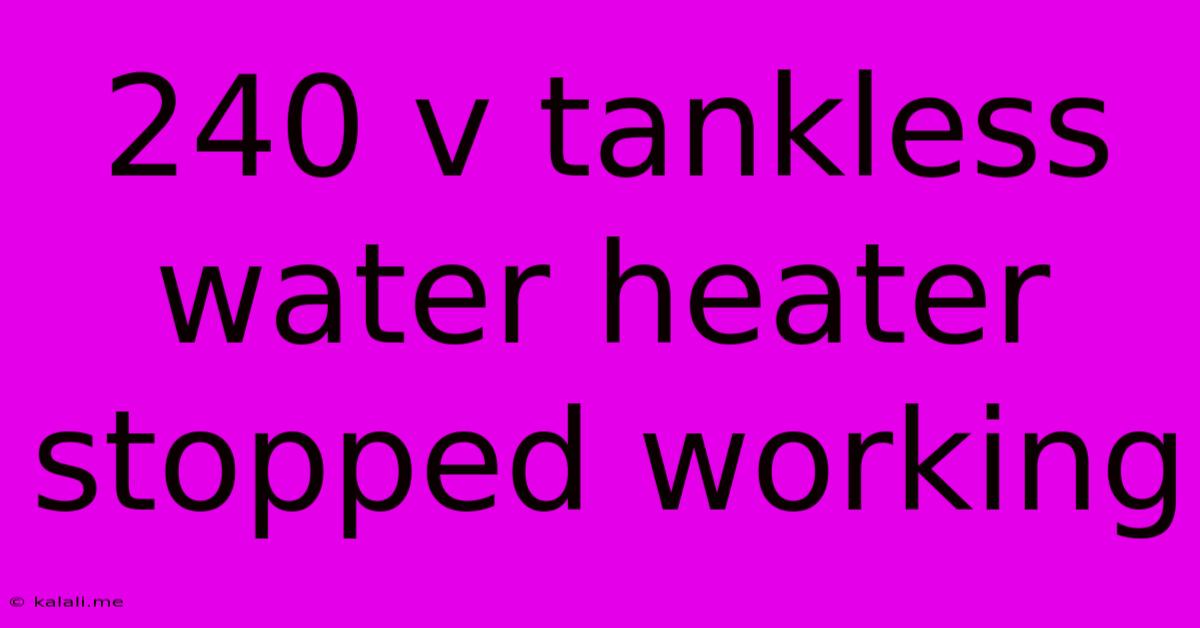240 V Tankless Water Heater Stopped Working
Kalali
Jun 03, 2025 · 3 min read

Table of Contents
My 240V Tankless Water Heater Stopped Working: Troubleshooting and Solutions
A sudden loss of hot water from your 240V tankless water heater can be incredibly disruptive. This article will guide you through troubleshooting common problems, helping you diagnose the issue and potentially fix it yourself, saving you the cost of a service call. Before you begin, remember safety first: always turn off the power to the unit at the breaker box before attempting any repairs.
Understanding Your 240V Tankless Water Heater
Tankless water heaters, also known as on-demand water heaters, heat water directly as it's needed, eliminating the need for a large storage tank. The 240V models provide higher power and flow rates compared to 120V units. Knowing the basics of your specific model is crucial for effective troubleshooting.
Common Reasons Your 240V Tankless Water Heater Stopped Working
Several factors can cause your tankless water heater to malfunction. Let's explore the most frequent culprits:
1. Power Supply Issues:
- Tripped Breaker: This is the most common reason. Check your electrical panel for a tripped breaker related to your water heater. Simply reset the breaker to restore power.
- Blown Fuse: Older systems might use fuses instead of breakers. Replace any blown fuses with the correct amperage rating.
- Loose Wiring: Inspect the wiring connections to the unit for any loose or damaged wires. Ensure they are securely fastened.
2. Water Supply Problems:
- Insufficient Water Pressure: Low water pressure can prevent the unit from operating correctly. Check your home's water pressure and address any leaks or restrictions.
- Sediment Buildup: Mineral deposits and sediment can clog the water inlet filter or internal components. Refer to your owner's manual for instructions on cleaning or replacing the filter.
- Frozen Pipes: In colder climates, frozen water supply pipes can prevent water flow to the heater. Thaw any frozen pipes carefully.
3. Internal Component Malfunctions:
- Faulty Heating Element: The heating element is a crucial component that heats the water. A burnt-out element requires replacement, typically requiring professional assistance.
- Flow Sensor Issues: This sensor detects water flow and activates the heating element. A malfunctioning flow sensor prevents the heater from working. This often requires professional repair or replacement.
- Control Board Problems: The control board manages the heater's operation. A faulty control board needs professional diagnosis and replacement. This is usually the most expensive repair.
- Gas Valve Issues (for gas-powered units): A malfunctioning gas valve can prevent the burner from igniting or maintaining the flame. This is a safety concern and necessitates professional attention.
4. Exhaust Ventilation Problems:
- Blocked Vent: If your unit vents exhaust gases outdoors, a blockage in the vent can cause malfunction. Clear any obstructions from the vent.
Troubleshooting Steps: A Systematic Approach
- Check the Power Supply: Start with the simplest checks—the breaker and fuses.
- Inspect the Water Supply: Ensure sufficient water pressure and check for clogs or frozen pipes.
- Examine the Water Inlet Filter: Clean or replace the filter if necessary.
- Listen for Sounds: Unusual noises, like clicking or humming, can indicate internal problems.
- Check Error Codes: Many tankless water heaters display error codes that pinpoint specific problems. Refer to your owner's manual for troubleshooting information related to these codes.
When to Call a Professional
While many issues can be resolved with simple troubleshooting, some problems require the expertise of a qualified technician. Call a professional if:
- You are uncomfortable working with electricity or gas appliances.
- You've checked all the obvious issues and the problem persists.
- You've identified a faulty component that requires replacement.
- You see error codes you don't understand.
By following these steps and understanding the potential causes, you can effectively troubleshoot your malfunctioning 240V tankless water heater and hopefully restore hot water to your home quickly and efficiently. Remember to always prioritize safety and consult a professional when necessary.
Latest Posts
Latest Posts
-
Where Can I Find Flint Stone
Jun 05, 2025
-
Sun And Moon In The Sky At The Same Time
Jun 05, 2025
-
What Can I Do After I Ssh Into A Server
Jun 05, 2025
-
Maximum Amperage For 12 Gauge Wire
Jun 05, 2025
-
How To Get Condensation Out Of Headlights
Jun 05, 2025
Related Post
Thank you for visiting our website which covers about 240 V Tankless Water Heater Stopped Working . We hope the information provided has been useful to you. Feel free to contact us if you have any questions or need further assistance. See you next time and don't miss to bookmark.